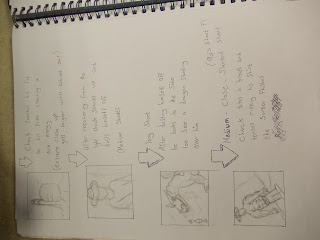Evaluation Of Walk Cycle
This was my first attempt of a walk cycle or animation, i animated my character walking across the screen into him walking away from the viewer it took me so much longer than i expected but after grasping and adapting to the techniques of tweening image manipulation and using the paint brush for broader lines and pencil for thine straight lines these were a massive part of animation to the zooming in of his eye where i just blew up the picture every 3 slides or so, this will all come in hand in the future for further animation considering what i have learned about flash the walk from the left to the right worked well it was fluid and he bobbed along but the walk away was slightly odd as his legs kind of flop in and out, but it is funny and entertaining, which is what the whole feel of the animation has and is what i'm aiming for. to improve my skills i just need to carry on working at it and developing my skills more in depth into tweening and drawing if i improve my drawing skills then i should become a better quality animator.
this is a screen shot of the comments under my video and i agree with them all i accept that the walk away from the viewer is odd and fluid but it is funny and i can say it is intentional. the hat moving i don't see a problem with as it moves with him giving the feel that he is bobbing along with style i like this evaluation and i am proud as it is my first ever attempt of anything of this sort next time i will be able to do it all a lot quicker and in better quality.
Evaluation of full Animation
Here is a screen shots of comments from my full animation on the whole i would say they do represent my work the style i went for was a naive style along the lines of "minecraft" and "binding of Isaac"
its very simple but very effective its easy to make out and uses a lot of block colour. I did try very hard with the lip syncing and i think it was successful and the comments agree with this and they seem to get the style i was going for which was a naive style simple and appealing to the eye.
The sound effects fit each scene and are in sync (although the youtube video may not show this) i have learned a lot from the making of this at the start i had never used Flash before but toward the end it was like second nature i leaned to use motion tween, shape tween, classic tween insert frame, insert blank key frame all the short cuts and much more i will not forget these techniques as i used them so regularly
i think the overall end of this animation was successful im very happy with the outcome.








